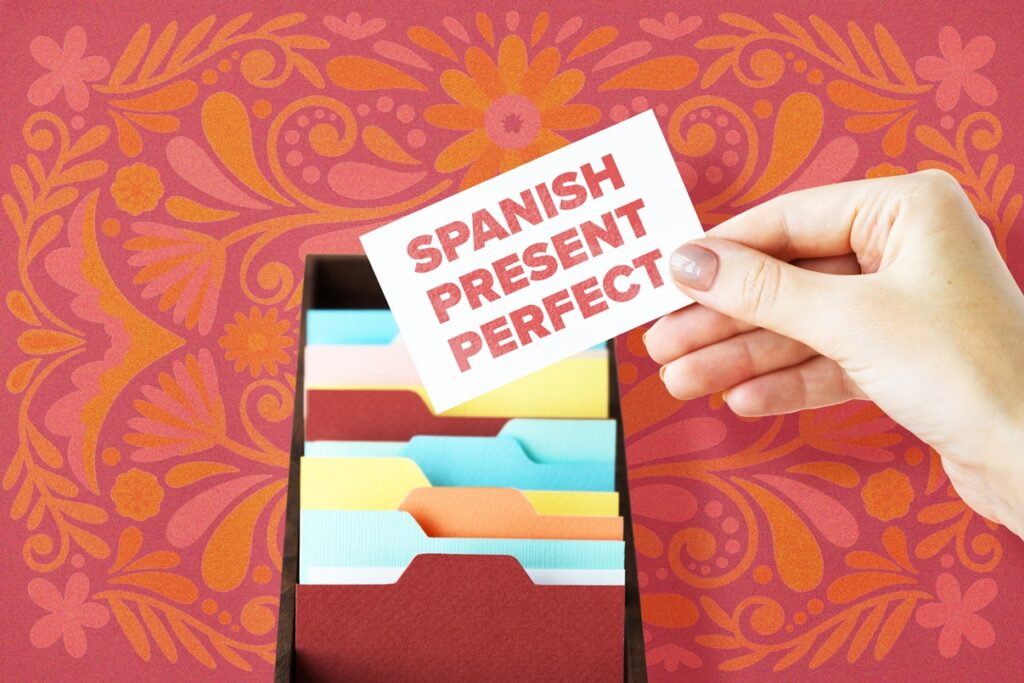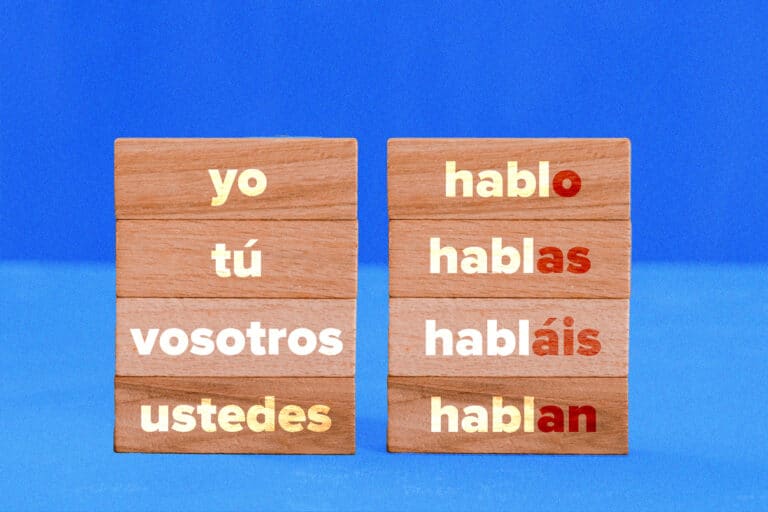How to Use the Present Perfect in Spanish

The Spanish present perfect tense is used to describe actions that happened in the past but affect the present. For example: “I have lost my wallet.” This simple sentence tells us that I lost my wallet in the past, but I still don’t have it—thus, it affects the present.
Let’s have a look at the Spanish present perfect tense, including how to use it, how to conjugate it and what words trigger it.
Download: This blog post is available as a convenient and portable PDF that you can take anywhere. Click here to get a copy. (Download)
The Spanish Present Perfect Tense
The Spanish present perfect tense consists of a conjugation of the verb haber (to have) plus the past participle. It talks about actions that happened in the past but are still happening or affecting the present.
Take these sentences as examples:
He estado aquí por tres años. (I have been here for three years.)
Ella ha cocinado el desayuno para ti. (She has cooked breakfast for you.)
Han visto esa película cuatro veces. (They have seen that movie four times.)
It’s actually similar to English, where you also use “has” or “have” in the present perfect tense.
Forming the Present Perfect Tense in Spanish
The Spanish present perfect is one of what I call “the easy tenses” because it’s used in very specific situations, is quite easy to conjugate and its similarities with English are remarkable.
The basic formula for conjugating is:
Haber (in present simple) + past participle
For example:
Ella ha comido la manzana. (She has eaten the apple.)
Yo he estudiado por tres horas. (I have studied for three hours.)
Conjugating Haber in Simple Present Tense
First, we’ll learn the conjugations of haber in the simple present tense, then how to conjugate the past participle.
| Pronoun | Conjugation | Meaning |
|---|---|---|
| Yo | He | I have |
| Tú | Has | You have |
| Él/Ella/Usted | Ha | He/she has, you (formal singular) have |
| Ellos/Ellas/Ustedes | Han | They/you (formal plural) have |
| Nosotros | Hemos | We have |
| Vosotros | Habéis | You have (informal plural) |
Conjugating the Past Participle
Here’s a quick refresher on how to conjugate the past participle:
1. Verbs ending in -ar change their ending to -ado
2. Verbs ending in -er and -ir change their ending to -ido
| Verb Type | Past Participle Ending | Example |
|---|---|---|
| -ar | -ado | Cantar (to sing) → Cantado (sung) |
| -er | -ido | Comer (to eat) → Comido (eaten) |
| -ir | -ido | Venir (to come) → Venido (come) |
If you haven’t mastered the past participle yet, check out our in-depth blog post here:
Past Participle in Spanish (Forming and Using It) | FluentU Spanish Blog
The past participle in Spanish isn’t just for the perfect tense. It can be used in many forms to express yourself in various ways. As a noun, adjective, adverb…even to…
Grammar Rules for the Present Perfect
There are a couple of small things you should know about the present perfect tense:
- Never separate haber from the past participle. This is one of the main differences between Spanish and English when it comes to the present perfect tense. You simply can’t add any word to the tense and break it apart. For example, if you want to say “I have never drunk alcohol in my life”:
Correct: Nunca he bebido alcohol en mi vida.
Incorrect: He nunca bebido alcohol en mi vida
- Pronouns always go before the present perfect, never after. For example, take “I have already told them the truth”:
Correct: Ya les he dicho la verdad.
Incorrect: Ya he dicho les la verdad.
The more you use and hear the present perfect, the more natural these rules will become. Make sure you get plenty of practice with native speakers and consume Spanish content any time you can.
You can solidify these rules even faster if you watch videos with subtitles—like the ones on FluentU—so you can see the present perfect used in context without feeling overwhelmed or accidentally missing it.
FluentU takes authentic videos—like music videos, movie trailers, news and inspiring talks—and turns them into personalized language learning lessons.
You can try FluentU for free for 2 weeks. Check out the website or download the iOS app or Android app.
P.S. If you decide to sign up now, you can take advantage of our current sale!

When to Use the Present Perfect
There are four main scenarios when you’d need to use the present perfect tense:
1. Recent Actions with Present Consequences
When a past action is actively affecting the present, it requires the present perfect. This is the rule that our first “I have lost my wallet” example follows.
However, you’ll hear the present perfect mostly in Spain, as Latin America prefers using the preterite in such cases.
Hemos comprado una casa. (We have bought a house.)
2. Action Which Started in the Past and Continues Today
Decisions you’ve made in the past have heavy effects on your current life, such as jobs you took, promotions you’ve got, moves to a new place, starting a new language learning journey and more.
These require the present perfect and are similar to the present perfect continuous in English.
He sido profesor de idiomas desde 2002. (I have been a language teacher since 2002.)
3. Talking About Previous Life Experiences
We talk about past experiences all the time in English, and in Spanish, we do so with the present perfect.
You can use the present perfect when something has happened a certain number of times in your life or when you’re expressing whether or not you have ever done something.
He oído que se ha casado cinco veces ya. (I have heard he has been married five times already.)
4. With Trigger Words
There are some words and expressions that trigger the use of the present perfect tense—meaning, when you see these words, usually the present perfect follows.
The present perfect is triggered by these words:
| Trigger Word | Meaning | Example |
|---|---|---|
| Nunca | Never | No hemos visto esa película nunca. (We have never watched that movie.) |
| Últimamente | Recently, lately | Ellos han estado trabajando últimamente. (They have been working lately.) |
| ... veces | ...times | Ya te lo he dicho tres veces. (I have already told you three times.) |
| Hoy | Today | Hoy he desayunado cereal con leche. (I ate cereal with milk for breakfast today.) |
| Esta mañana / esta tarde / esta noche | This morning/afternoon/tonight | He comido mucho esta noche. (I have eaten a lot tonight.) |
| Esta semana / este mes / este año | This week, this month, this year | Esta semana no he podido trabajar. (I have not been able to work this week.) |
| Ya | Already | Ya hemos llegado a casa. (We have already arrived home.) |
| Aún | Yet | No he decidido qué hacer aún. (I have not decided what to do yet.) |
| Todavía | Still | No hemos pagado las facturas todavía. (We have still not paid the bills yet.) |
| En mi vida | In my life | Nunca he hablado con él en mi vida. (I have never talked to him in my life.) |
Present Perfect vs. Present Simple
So how is the present perfect different from the present simple, then?
The biggest difference is that the present simple talks about actions that happen in the present habitually or routinely. In contrast, the present perfect is used for completed actions that still affect the present.
Look at these sentences in the present tense:
Me levanto a las ocho de la mañana. (I get up at 8 o’clock in the morning.)
Ella aprende español. (She learns/is learning Spanish.)
Now, see how conjugating the same verbs in the present perfect changes the meaning:
Ya me he levantado. (I have already gotten up.)
Ella ha aprendido español por tres meses. (She has learned Spanish for three months.)
The present perfect is an easy tense that we use every day in lots of contexts and situations.
Add it to your Spanish lore and make your friends go “woah!” with your fantastic use of it!
Download: This blog post is available as a convenient and portable PDF that you can take anywhere. Click here to get a copy. (Download)
And One More Thing…
If you've made it this far that means you probably enjoy learning Spanish with engaging material and will then love FluentU.
Other sites use scripted content. FluentU uses a natural approach that helps you ease into the Spanish language and culture over time. You’ll learn Spanish as it’s actually spoken by real people.
FluentU has a wide variety of videos, as you can see here:

FluentU brings native videos within reach with interactive transcripts. You can tap on any word to look it up instantly. Every definition has examples that have been written to help you understand how the word is used. If you see an interesting word you don’t know, you can add it to a vocab list.

Review a complete interactive transcript under the Dialogue tab, and find words and phrases listed under Vocab.

Learn all the vocabulary in any video with FluentU’s robust learning engine. Swipe left or right to see more examples of the word you’re on.

The best part is that FluentU keeps track of the vocabulary that you’re learning, and gives you extra practice with difficult words. It'll even remind you when it’s time to review what you’ve learned. Every learner has a truly personalized experience, even if they’re learning with the same video.
Start using the FluentU website on your computer or tablet or, better yet, download the FluentU app from the iTunes or Google Play store. Click here to take advantage of our current sale! (Expires at the end of this month.)







